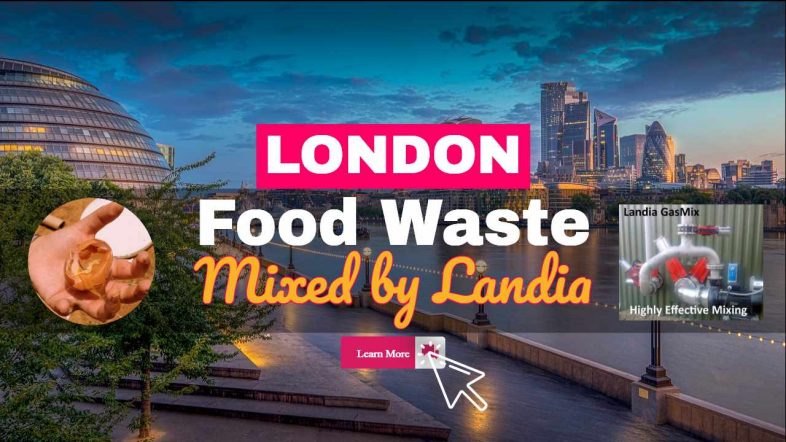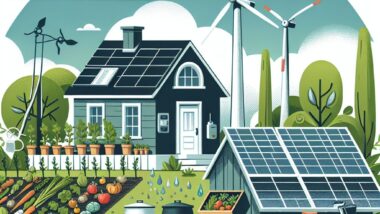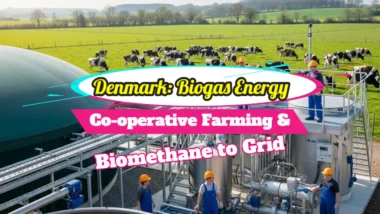Food waste in London is piling up faster than many realise. Households, restaurants, and shops toss out leftovers daily, creating a mountain of rubbish that clogs landfills and fuels climate change.
The issue isn’t just scraps on plates; it’s also the plastic bags wrapped around them and the energy lost producing uneaten food.
Did you know London churns out nearly 2 million tonnes of food waste every year? Shockingly, about one-third of this ends up where it shouldn’t: landfill. This rotting mess releases methane gas, which traps even more heat than carbon dioxide.
The solution lies in smarter recycling systems and sustainable habits.
This blog will uncover practical ways to tackle London’s food waste crisis without overcomplicating your life or budget. We’ve got ideas ranging from home composting tips to borough-wide programmes turning scraps into biogas.
Small changes can make big impacts! Read on for fresh solutions that might surprise you.
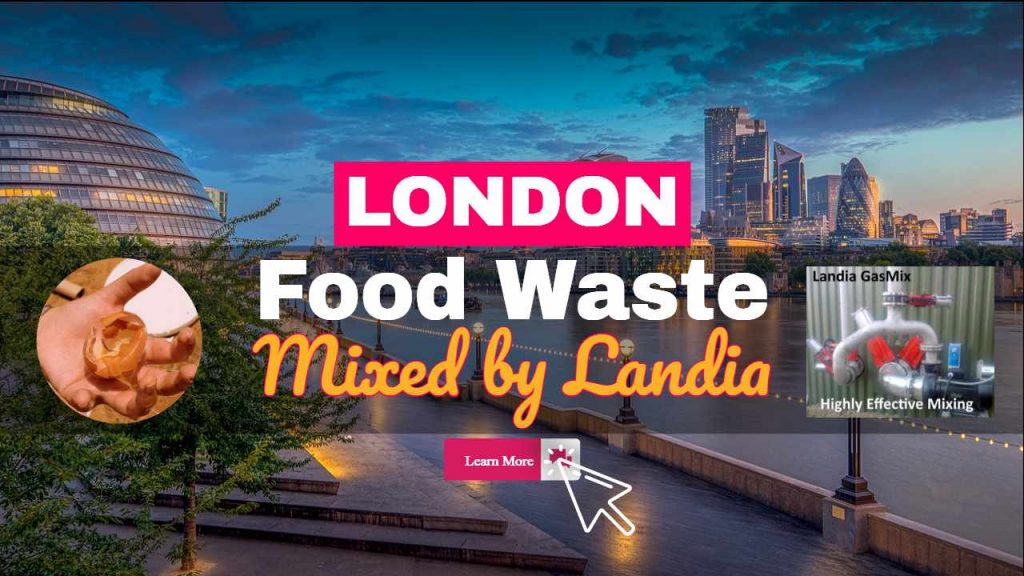
Key Takeaways
- London generates nearly 2 million tonnes of food waste annually, with households contributing over 900,000 tonnes. About one-third ends up in landfills, releasing methane—a greenhouse gas 65 times more potent than carbon dioxide.
- Households lose £600 annually due to wasted food, while businesses face £3 billion losses from unsold goods. Food-sharing apps like Olio help redistribute surplus and cut costs.
- Weekly food recycling collections in some London boroughs provide free caddies and bins for scraps such as peels or leftovers. This reduces landfill waste and promotes composting.
- Partnerships like Landia and BIO Collectors use anaerobic digestion technology to turn waste into biogas, reducing pollution while supporting the circular economy.
- Challenges remain due to limited infrastructure, funding gaps, and rigid contracts preventing programme expansion across all boroughs. England’s recycling rate remains at only 35%.
Food Waste Generation in London
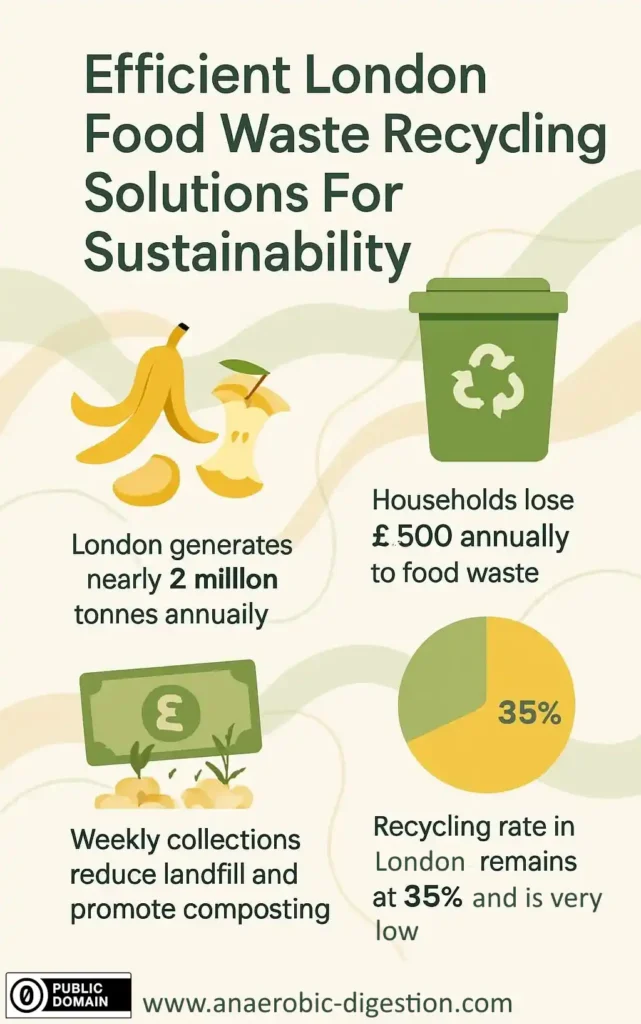
London produces mountains of food waste every year. This waste affects the environment and eats into household budgets.
Impact on households and businesses
Households throw away about £600 worth of food annually, much of it still edible. This isn’t just money wasted; it’s resources squandered across the entire food supply chain. With 70% of food waste originating from homes, the financial burden hits families hard.
Unused groceries clog bins and increase household waste disposal costs. Retailers face similar challenges as unsold perishable items contribute to mounting losses.
Restaurants and shops grapple with expired stock, stricter regulations on disposal methods, and rising fees for incineration or recycling services. Plastic packaging around discarded goods also adds to their troubles by complicating sustainable waste solutions.
Businesses could reduce this impact by using food sharing apps like The Felix Project or switching to biodegradable bags for a low-carbon alternative in managing waste sustainably.
Environmental consequences
Food waste causes serious environmental challenges. Most of it ends up in landfills, where rotting food releases methane. Methane is a greenhouse gas at least 65 times more potent than carbon dioxide, making it a significant contributor to the climate crisis.
Burning food waste also increases emissions, as carbon is released back into the atmosphere during the process.
Incorrect recycling affects not just air quality but also soils and farming systems. For instance, discarding leftovers results in the loss of valuable nutrients such as nitrogen and potassium naturally present in foods.
These could restore soil when converted into digestate through anaerobic digestion processes. Rather than returning vital fertilisers to the earth, they are permanently lost to our food system while causing further damage.
Every bite wasted places a strain both on your business and the planet.
Retailers play a crucial part in reducing food loss and waste at the source or redirecting scraps into sustainable solutions such as energy production through recyclers instead of disposing of them in landfills or incinerators.
London Boroughs' Food Waste Recycling Programs
London boroughs tackle food waste in different ways. Some face hurdles, while others explore bold partnerships and technology.
Challenges and limitations
Some boroughs struggle with food waste recycling due to poor infrastructure and rigid contracts. Without proper facilities, recyclables often end up incinerated or in landfills, increasing the carbon footprint.
England's food waste recycling rate remains stuck at 35%, showing widespread inefficiencies.
Local authorities face funding gaps that prevent system upgrades for households and businesses. Limited anaerobic digestion plants fail to meet the rising demand for processing food wastes.
Retail managers may also deal with scattered garden waste disposal rules across areas, causing confusion and delays in sustainable practices.

Innovative solutions and partnerships
Collaborations between Landia and BIO Collectors improve food waste recycling in London. They use advanced mixer technology to boost efficiency during anaerobic digestion. This process transforms discarded food into valuable energy sources like biogas.
Their partnership reduces waste pollution while feeding the circular economy.
Food-sharing apps, such as Olio, tackle surplus by connecting businesses with locals. Retailers can list unsold items for reuse instead of discarding them. These tools cut down landfill contributions and provide households with more affordable diets.
Such partnerships foster sustainability and strengthen local communities effectively.
Specific Examples of Food Waste Recycling Initiatives in London
Londoners are getting creative with managing food scraps, turning yesterday's leftovers into tomorrow’s resources. Local schemes embrace tech tools and old-school methods to tackle waste efficiently.
Permanent residential recycling services
Certain boroughs in London have introduced permanent residential food waste recycling services with great success. These programmes simplify recycling for households, reducing the amount of rubbish sent to landfills.
For instance, some areas provide dedicated bins for scraps like vegetable peels and leftovers. Such steps convert food waste into compost and soil nutrients rather than letting it rot in a tip.
Retailers gain advantages too when local communities adopt sustainable habits. Consistent recycling programmes can encourage customers to expect eco-friendly actions from their favourite shops.
This expectation drives businesses towards solutions that contribute to a greener planet. Weekly collections also ensure minimal disruption, directly leading to discussions on those efforts' impact across various boroughs next!
Weekly food waste collections
Weekly collections when the new Simpler Recycling household food waste collection regulations come into force in April 226 will help handle food waste in England more effectively. Many London boroughs will offer free caddies for kitchen use and larger bins for communal spaces. This service simplifies sustainable food recycling for households, reducing stress on landfills.
Retail shops can encourage staff to use these services at home while adopting similar practices commercially. Confirm with local councils if your area provides such schemes, as not every borough participates in weekly pickups yet.

Use of food waste sharing apps
Weekly food waste collections play a critical role in reducing excess, but apps like Olio expand on this effort. These platforms allow shops, restaurants, and individuals to share surplus food with ease.
Rather than letting edible goods end up as household waste, these items find value through redistribution.
Retailers can list unsold products nearing expiration dates. Neighbours or local organisations then claim them for free. This reduces landfill costs and cuts greenhouse gas emissions linked to wasted food decay.
Local authorities benefit from decreased waste volume while businesses improve their eco-friendly image without spending extra resources.
Collaborations between councils and apps like Olio strengthen community ties too. Shops often avoid large disposal fees when they use such solutions creatively. As demand continues growing, innovation in sharing systems provides scalable benefits for London boroughs addressing the issue of recycled materials responsibly.
Staying proactive slashes emissions and saves money too. Up next, how much impact does food waste really have on London's environment?
Updated Information on Food Waste Generation and Recycling in London
London generates mountains of food waste daily, pushing councils and residents to tackle emissions and costs—read more to uncover fresh solutions.
Statistics on food waste generation
Food waste is a persistent issue in both households and businesses. Retailers face significant challenges when food waste isn’t handled well. Below is a snapshot of key statistics regarding food waste generation in London, highlighting its scale and implications.
| Statistics | Details |
|---|---|
| Annual Food Waste in London | Nearly 2 million tonnes of food are wasted each year across London. |
| Avoidable Waste in Black Bags | Over 50% of food waste found in black bags is avoidable. |
| Household Contribution | London households contribute over 900,000 tonnes annually. |
| Environmental Impact | Food waste accounts for one of the largest portions of greenhouse gas emissions. |
| Financial Impacts | Estimated £250 to £400 lost per household yearly due to avoidable waste. |
| Retail Industry Losses | Shops report millions in lost revenue from unsold, wasted food. |
| Impact on Black Bag Waste | Food waste is the largest single component in black bag rubbish. |
Food waste significantly reduces profits and also harms the environment. With these figures in mind, addressing inefficiency benefits both business and the planet.
Effect on greenhouse gas emissions
Methane emissions from landfills drastically affect the environment. This gas, 65 times more potent than carbon dioxide, results from decomposing organic waste like food scraps. London households and businesses produce tonnes of this waste yearly, intensifying greenhouse gas levels.
Recycling programmes in London reduce these harmful emissions by diverting waste away from landfills. Shop managers can play a role by managing their inventory better to cut down on expired goods ending up as rubbish.
Using solutions such as Landia Mixer Case Study technology aids in processing leftover food efficiently while lowering methane release.
Financial impact on households and businesses
Food waste doesn’t just hurt the planet; it also burns a hole in wallets. The financial toll on households and businesses is staggering. Below is a breakdown to help you connect the dots:
| Impact | Statistics | Examples |
|---|---|---|
| Household Losses | £600 per household per year | Food like bread, fruit, and dairy is often wasted while still edible. |
| Business Waste | £3 billion annually | Unsold bakery items or surplus stock contribute heavily to waste. |
| Environmental Costs | Over £20 million in landfill taxes | Businesses face fines for improper waste handling. |
| Supply Chain Impact | Higher operational costs | Spoiled produce leads to increased procurement spending. |
| Recycling Challenges | Varied borough recycling rules | Businesses often pay third-party providers to manage food waste. |
This table shows the ripple effect. Households lose hundreds annually, yet businesses see even larger losses. For retail managers, better stock control and food redistribution apps could help reduce waste while saving cash.
Current Status of Food Waste Recycling Programs in London
Local councils have started tackling food waste with more targeted recycling efforts. Businesses and households are stepping up to cut down what ends up in landfills.
Implementation of residential recycling services
Councils in London offer permanent residential food waste recycling to reduce landfill. Boroughs provide caddies to households and bins for communal spaces, encouraging consistent participation.
Weekly collections ensure household waste disposal remains efficient. This system helps retail managers connect with eco-conscious customers by showcasing sustainability initiatives nearby.
Challenges faced by local authorities
Establishing food waste recycling in certain parts of London faces challenges. Restrictions within contracts between councils and private waste management firms cause delays. Some agreements are not adaptable enough for new programmes, limiting boroughs' ability to expand services effectively.
Infrastructure also presents obstacles. Outdated facilities or a total lack of adequate systems leave some boroughs unable to cope with households' increasing organic waste. With England’s food waste recycling rate remaining at just 35%, the disparity is clear, impacting both sustainability targets and local operations.

Potential solutions and initiatives
Authorities in London explore partnerships to address food waste challenges. Collaborations like the one between Landia and BIO Collectors improve anaerobic digestion processes for handling waste efficiently.
Retail managers can engage with these advancements to reduce disposal costs while promoting sustainability.
Food sharing apps such as Olio offer practical tools for shops. These platforms connect businesses with households eager to repurpose unsold food, cutting down unnecessary waste. Weekly collections by borough councils also help retail establishments manage refuse better, keeping operations smooth and eco-friendly.
Don't Forget Food Poverty
Despite the fact that much of our food is wasted, many people in London struggle to make ends meet. At times they find themselves short of the money they need even to feed themselves and their families.
A surplus food redistribution charity like City Harvest is an example to solve this problem. It's been dubbed London's long-term answer to surplus food and food insecurity.
They distribute extra food to over 350 charities, food banks, schools, and community organisations for free in every London area. This and other nonprofits do incredible work to feed those who are hungry.
But, returning to the need for efficient recycling of food into energy, read on to find out about how the experts mix food waste while producing very valuable renewable energy:
Press Feature – BIO Collectors/Landia:
Landia and BIO-Collectors™ Mix Food Waste in London
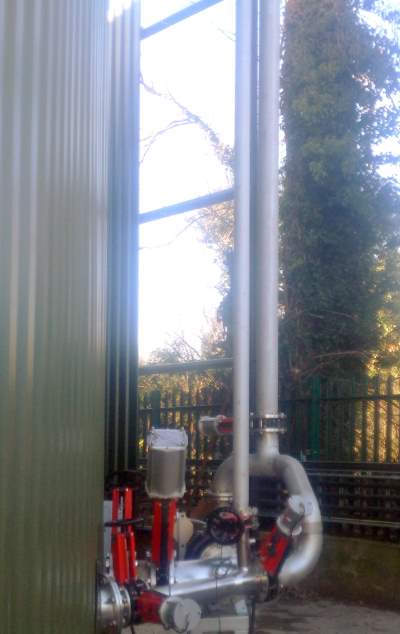 In tackling London’s food waste, of which it processes 75,000 tonnes pa, BIO Collectors’ Paul Killoughery almost nonchalantly describes the 1.7MW electricity produced as ‘the easiest thing we do’.
In tackling London’s food waste, of which it processes 75,000 tonnes pa, BIO Collectors’ Paul Killoughery almost nonchalantly describes the 1.7MW electricity produced as ‘the easiest thing we do’.
Of course, there’s much more to it than that, but the efficiency and effectiveness of this trouble-free anaerobic digestion operation isn’t down to luck – the Managing Director and Founder of London’s largest independent AD food waste recycling plant made it his business to take ownership of the system that converts all that food waste into biogas, electricity and fertiliser.
“Everybody knows that for AD, achieving the best possible mixing for your tank is the key”, said Paul Killoughery, “and in achieving that here for the past four and half years at our site in Mitcham, we haven’t even spent as much as £1,000 on parts. Our homework has certainly paid off”.
As a newcomer to the industry, those early reconnaissance missions saw BIO Collectors make visits to key exhibitions and sites both in the UK and mainland Europe, where the company gained a warts and all insight into what AD operators were experiencing.
“Very early on we decided that we definitely didn’t want mixers inside the tank that we couldn’t get to”,
added Paul Killoughery.
“Naturally, we wanted our tanks to be mixed properly, but for us to manage our own plant on a day to day basis, and put right any wrongs, we simply had to have equipment that was easily serviceable and repairable from the outside. As it happens though, things haven’t gone wrong. We’ve had no major problems whatsoever”.
He continued:
“We heard horror stories of crust becoming so thick that it had broken the tank, making it impossible to retrieve mixers, so we chose a proven system that wouldn’t see the development of different layers of waste within a tank. For our regime, everything had to be mixed properly, with never any sign of a crust. In fact, Landia, the manufacturer we chose to work with, for their externally-mounted GasMix system, said that we could achieve our needs with three mixers, but because our philosophy is that everything has a redundancy, we decided on four: two GasMix and two separate Landia propeller mixers (also externally-mounted), so that we always have back up. Another big plus for us was knowing that unlike many, Landia has the manpower and the spare parts right here in the UK to offer us immediate help if and when we ever need it”.
BIO Collectors’ AD operation in Surrey is unusual in as much that it operates along very similar lines to how the water industry generates renewable energy from sewage sludge. The Mitcham plant began as an aerobic/composting site, which worked well, but ultimately wasn’t considered to be the best business model. After BIO Collectors bought the business, they decided to add an AD plant, creating a two-phase system that sees the aerobic treatment pasteurise and hydrolyse the food waste, making it easier for the methane bugs to work – before pumping the liquid into the AD tanks.
Whilst the vast majority of tanks rely on hydrolyzation in the AD tank, BIO Collectors already has this part of the process completed. The net result is a very significant 30%-plus reduction in retention time.
“It’s not what one would choose to build from the offset”,
said Paul Killoughery,
“but as it does for water companies, it works very well for us. We probably do more mixing than most, and we get great gas – quickly. Energy usage was a secondary consideration, but we currently only use the Landia GasMix at a rate of 5 minutes on and 10 minutes off – and depending on what we see and how high our gas levels are, we can choose to turn off the propeller mixers if we need to. We also use our Landia pumps to pump from our AD tank back into the AD liquor store, so we don’t need a separate pump for that task. For its installation, the other advantage we saw with the Landia GasMix was that it didn’t require extra structure for the tank, nor a concrete lid, which would have been far more complex. We’ve double-valved everything and are fully bunded, as well as having everything protected from vehicles, but the AD part of our business is still the easiest. If you understand the process and realise that the right mixing is essential, then it doesn’t have to be complicated”.
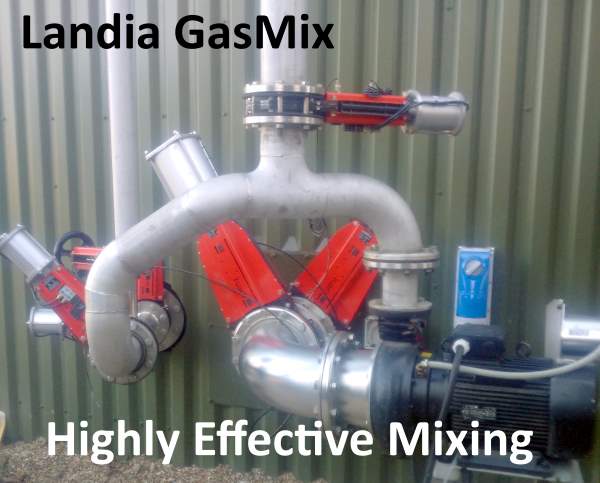
The only gas-to-grid food waste operation in Greater London, and one of only three in the whole of the South East, BIO Collectors has contracts with the likes of Sainsbury’s and Pizza Hut, also collecting bulk waste from distribution centres, plus schools, hospitals and hotels, as well as liquid waste from breweries and factories. With only just over 50% of London’s 33 borough councils collecting food waste separately, the company wants to see the same rules implemented that have helped bring about vast improvements in Scotland, Wales and Northern Ireland – improvements that have left England lagging way behind with a recycling rate of just 35%.
“The result of good mixing has also produced top quality digestate”, said Paul Killoughrey. “It is high in NPK (Nitrogen, Phosphorus, Potassium) and very popular with the arable farms in Surrey who see increased yields. Our PAS 110 test for residual biogas conclusively shows that our mixing system is working to an extremely high standard. It is a major benefit to the whole process”.
Landia Mixers: Call 01948 661 200
[First published in March 2017. Updated November 2021.]
London Food Waste Conclusion
Tackling food waste in London is no small feat, but progress is happening. Recycling programmes and community efforts are making a real difference. Simple steps like weekly collections or sharing surplus can help cut mountains of waste.
Fighting food waste in London needs teamwork and creativity. Small actions, like sorting waste at home or using food-sharing apps, can make a big impact. Businesses have a role too, from donating surplus stock to supporting recycling plants.
Together, we can cut landfill pollution and save valuable resources. Every step counts toward a cleaner, greener city!
FAQs About London Food Waste Recycling
1. What are the benefits of food waste recycling in London?
Food waste recycling helps reduce landfill use and lowers greenhouse gas emissions. It also supports sustainability by turning waste into compost or energy.
2. How can households manage their food waste better?
Households can separate food scraps from general rubbish. Use local recycling bins or services to dispose of them properly.
3. Are there efficient solutions for handling household food waste in London?
Yes, many councils provide dedicated bins for organic waste collection. Some areas even offer community composting schemes.
4. Why is it important to recycle food waste sustainably?
Recycling reduces environmental harm caused by rotting waste in landfills. It also conserves resources while promoting a cleaner city environment.

